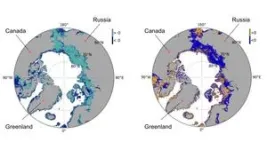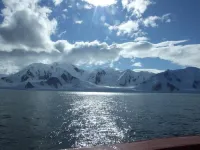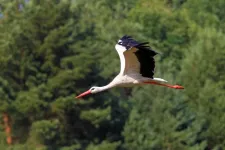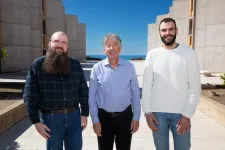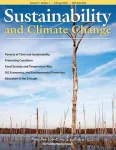(Press-News.org) Over the past 25 years, the amount of summer Arctic sea ice has diminished by more than 1 million square kilometers. As a result, vast areas of the Arctic Ocean are now, on average, ice free in summer. Scientists are closely monitoring how this impacts sunlight availability and marine ecosystems in the far north.
“Many questions arise when such large areas become ice-free and can receive sunlight. A prevailing paradigm suggests that the Arctic Ocean is rapidly becoming more productive as sunlight becomes more abundant in the marine environment. However, it is unclear how ecosystems will evolve in response to increasing sunlight availability and how different components will be affected”, says Karl Attard, a marine scientist and Assistant Professor at the Department of Biology, University of Southern Denmark.
Attard has led an international research team investigating sunlight availability and photosynthetic production on the understudied Arctic seafloor. Their study has been published in the scientific journal Proceedings of the National Academy of Sciences (PNAS).
The research team focused on the vast shelf regions of the Arctic Ocean; portions of the seafloor that are relatively shallow, rarely exceeding 200 meters in depth. These vast regions, accounting for around half of the Arctic Ocean area, make it particularly interesting to study how seafloor ecosystems respond as sea ice continues to diminish.
Sunlight is a crucial energy source for life forms that grow through photosynthesis; they require water, carbon dioxide, nutrients, and sunlight. Scientists refer to these organisms as primary producers, and they thrive within the sea ice, within the water column, and on the seafloor. These organisms serve as the foundation for a broader food web in the ocean, supporting commercially important fisheries and large predators like polar bears. The main primary producers on the seafloor are microalgae, seaweeds, and seagrasses.
“It might seem reasonable to assume that the abundance of primary producers on the seafloor in the shallower regions of the Arctic Ocean would increase as more sunlight reaches the bottom. In fact, our research suggests that since 2003, the seafloor area exposed to sunlight has been increasing rapidly at around 47000 square kilometers per year. Curiously, however, we do not see an increase in the total amount of sunlight reaching the Arctic seafloor," says Karl Attard, referring to the research team’s models based on 20 years of satellite data from the Arctic Ocean.
This surprising result is seemingly due to water transparency, which has decreased in many parts of the Arctic Ocean.
“Sunlight reaching the ice-free ocean is rapidly absorbed by phytoplankton, sediments, and dissolved substances in the water, preventing much of the sun’s rays from reaching the seafloor. Our models predict increases in primary production in some regions but not in others, even though all these regions are now ice-free and receive sunlight at the ocean surface”, explains Karl Attard.
The explanation for the murky water lies in the fact that the Arctic Ocean is surrounded by land, and some of the world’s largest rivers flow into it. With the river water comes numerous particles from the catchment areas through which the rivers pass, and these particles can cloud significant portions of the Arctic Ocean.
These rivers originate as far away as Mongolia or central North America, carrying substantial amounts of particles with them when they flow into the Arctic Ocean. The river water also contains dissolved molecules which color the water and absorb sunlight.
In the researchers’ models, there are regional variations in the amount of biomass produced at the bottom of the new ice-free areas. The models indicate an increase in primary production in several places along Greenland and Canada’s extensive coastlines. Conversely, there is a decline in primary production on much of the Russian continental shelf.
“The question then arises: why does sunlight availability and primary production increase in some areas while diminishing in others? Unfortunately, our models do not provide a clear answer as to what specifically is driving this change, and obtaining this information necessitates investigating individual regions and validating our models with more observational data. The latest models suggest that seaweeds and eelgrass will establish themselves on the shallow coastal seafloor and will expand into the Arctic Ocean as the ice further diminishes and water temperature increases”, says Karl Attard, adding: “Here too, more observations are needed to test the uncertainties in the models.”
Traditionally, eelgrass and seaweeds struggle in ice-filled waters because the ice reduces sunlight availability and grinds and damages their tissues. However, in increasingly ice-free waters, extensive fields of underwater vegetation may emerge, serving as habitats for fish fry and other organisms.
The primary production calculated by the researchers for the Arctic Ocean seafloor is only a part of the total marine primary production, which also occurs in the water column and within sea ice.
“We have for the first time estimated seafloor primary production by microalgae, eelgrass, and seaweeds, and it is significant. We estimate that it is four times larger than the production in sea ice, which has received greater attention and is better represented within our understanding of Arctic ecosystems. Including all components of marine primary production is crucial for understanding what is happening within Arctic Ocean ecosystems”, says Karl Attard.
The Arctic Ocean has been undergoing rapid environmental change over the past decades, and he expects these transformations to continue.
“Our study suggests that the impacts of climate change on sunlight availability and primary production in the Arctic Ocean are complex. Additionally, as the Arctic Ocean continues to warm, we may witness more species migrating from lower latitudes, potentially leading to a more productive marine environment than what exists today—at the cost of losing what is special for the Arctic”, he says.
Karl Attard is Assistant Professor of Marine Science at the Department of Biology, University of Southern Denmark and a Fellow at the Danish Institute for Advanced Study. He studies marine ecosystems and ocean productivity. Attard has participated in over 30 international expeditions, including to the Arctic, Antarctica, and remote islands in the Pacific and Atlantic. His research is supported by the Independent Research Fund Denmark through a Sapere Aude project.
END
Less ice in the arctic ocean has complex effects on marine ecosystems and ocean productivity
2024-03-04
ELSE PRESS RELEASES FROM THIS DATE:
Antarctica’s coasts are becoming less icy
2024-03-04
EMBARGOED UNTIL MARCH 4, 2024 AT 3:00PM U.S EASTERN TIME
An increase in pockets of open water in Antarctica’s sea ice (polynyas) may mean coastal plants and animals could one day establish on the continent, University of Otago-led research suggests.
The research, published in the prestigious international journal Proceedings of the National Academy of Science, aimed at understanding where open water might allow coastal species to settle in the future.
Led by Research Fellow Dr Grant Duffy from Otago’s Department ...
New research shows migrating animals learn by experience
2024-03-04
THIS RELEASE IS EMBARGOED UNTIL MARCH 4, 2024, at 3:00 PM U.S. EASTERN TIME.
Research led by scientists from University of Wyoming and Max Planck Institute of Animal Behavior shows that migrating animals refine their behavior as they get older, suggesting that experiential learning is an important part of successful migration.
While genetics and social behavior are important factors shaping animal migrations, information gained through individual experience also appears to help shape migratory movements, says a research team led by Ellen Aikens. Aikens, ...
Modeling the origins of life: New evidence for an “RNA World”
2024-03-04
LA JOLLA (March 4, 2024)—Charles Darwin described evolution as "descent with modification." Genetic information in the form of DNA sequences is copied and passed down from one generation to the next. But this process must also be somewhat flexible, allowing slight variations of genes to arise over time and introduce new traits into the population.
But how did all of this begin? In the origins of life, long before cells and proteins and DNA, could a similar sort of evolution have taken place on a simpler scale? ...
Scientists put forth a smarter way to protect a smarter grid
2024-03-04
RICHLAND, Wash.—There’s a down side to “smart” devices: They can be hacked.
That makes the electric grid, increasingly chock full of devices that interact with one another and make critical decisions, vulnerable to bad actors who might try to turn off the power, damage the system or worse.
But smart devices are a big part of our future as the world moves more toward renewable energy and the many new devices to manage it. Already, such tools play a big role in keeping the power humming. The portion of the grid owned by ...
An evolutionary mystery 125 million years in the making
2024-03-04
Plant genomics has come a long way since Cold Spring Harbor Laboratory (CSHL) helped sequence the first plant genome. But engineering the perfect crop is still, in many ways, a game of chance. Making the same DNA mutation in two different plants doesn’t always give us the crop traits we want. The question is why not? CSHL plant biologists just dug up a reason.
CSHL Professor and HHMI Investigator Zachary Lippman and his team discovered that tomato and Arabidopsis thaliana plants can use very different regulatory systems to control the same exact ...
Data science approach to identifying thermal conductivity-related structural factors in amorphous materials
2024-03-04
1. Using data science techniques, a NIMS–Tohoku University research team has discovered that different thermal conductivities exhibited by an amorphous material with the same composition are attributable to the sizes of atomic rings in its atomic structure. This is one of the first studies demonstrating that the structural features of amorphous materials can be correlated with their physical properties.
2. It is already feasible to synthesize amorphous materials with the same compositions but different thermal conductivities. However, the structural factors responsible for differences in thermal conductivity had yet to be identified due to a lack of appropriate analytical ...
Deciphering the male breast cancer genome
2024-03-04
Male breast cancer has distinct alterations in the tumor genome that may suggest potential treatment targets, according to a study by Weill Cornell Medicine investigators. They have conducted the first whole genome sequencing analysis of male breast cancer, which looked at the complete DNA landscape of tumor samples from 10 patients.
This is an important step in viewing breast cancer in men, which represents less than 1 percent of all breast cancer cases each year, as a unique disease. Though most research has focused on women with breast cancer, the incidence in men has increased at a much faster rate than in women over the last 40 years. Also, ...
Detection of suicide-related emergencies among children using real-world clinical data: A free webinar from the Brain & Behavior Research Foundation
2024-03-04
According to the CDC, the suicide rate among young people ages 10‒24 increased 62% from 2007 through 2021. The CDC’s Youth Risk Behavior Summary reports that in 2021, 22% of high school students seriously considered attempting suicide during the year and 18% made a suicide plan. These statistics indicate a mental health crisis facing our youth. How can we identify children in crisis? Who is being missed?
The Brain & Behavior Research Foundation (BBRF) is hosting a free webinar, “Detection of Suicide-Related Emergencies Among ...
Editor-in-Chief of Sustainability and Climate Change Madhavi Venkatesan named USA TODAY Woman of the Year for Massachusetts for leading plastic bottle ban efforts
2024-03-04
Madhavi Venkatesan, PhD, Editor-in-Chief of the peer-reviewed journal Sustainability and Climate Change and founder of Sustainable Practices, has been named USA TODAY Woman of the Year for the state of Massachusetts in recognition of her outstanding efforts to eliminate single-use plastic bottles across Cape Cod and the Islands.
With economics and sustainability at the forefront, Venkatesan established Sustainable Practices in 2016, aiming to address pressing environmental issues through innovative solutions. Since then, she and her nonprofit team have spearheaded ...
Tests show high-temperature superconducting magnets are ready for fusion
2024-03-04
In the predawn hours of Sept. 5, 2021, engineers achieved a major milestone in the labs of MIT’s Plasma Science and Fusion Center (PSFC), when a new type of magnet, made from high-temperature superconducting material, achieved a world-record magnetic field strength of 20 tesla for a large-scale magnet. That’s the intensity needed to build a fusion power plant that is expected to produce a net output of power and potentially usher in an era of virtually limitless power production.
The test was immediately declared ...


